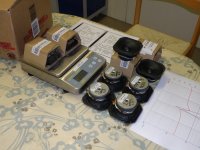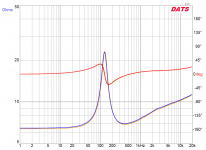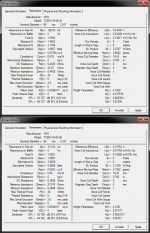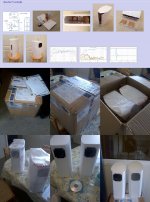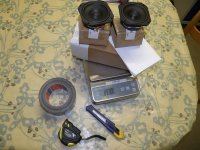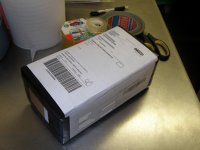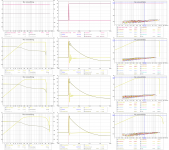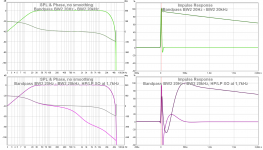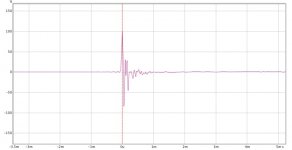Perceval, sorry delay got busy other stuff.
Todays afternoon got made some progress regarding the drivers in that got all eight analyzed their TS-parameters and impedance curves with DATS device so could match them best possible as 4 pairs. The pair prepared for Taiwan is on weight below and also impedance curves and TS data is attached, their history is they from a 4xTC9FD order europe-audio January 2015 and brand new only breaking in is DATS sweeps. Weight drivers is 0,646kg and will try make package 12x24x10cm <1,0kg because at www.pakke.dk they offer that data shipped to Taiwan within 2-4 business days at around 35€. Its expensive compared their cost was 17€ a piece inclusive shipping, but compared the US $79,15 it did cost shipping a pair DCR's from xrk971 to Denmark back in april seen picture 4, think 35€ sounds as is at least cost expected. In short time will PM you and tomorrow get back with data regarding ringing and HF extension for Aura driver.
Todays afternoon got made some progress regarding the drivers in that got all eight analyzed their TS-parameters and impedance curves with DATS device so could match them best possible as 4 pairs. The pair prepared for Taiwan is on weight below and also impedance curves and TS data is attached, their history is they from a 4xTC9FD order europe-audio January 2015 and brand new only breaking in is DATS sweeps. Weight drivers is 0,646kg and will try make package 12x24x10cm <1,0kg because at www.pakke.dk they offer that data shipped to Taiwan within 2-4 business days at around 35€. Its expensive compared their cost was 17€ a piece inclusive shipping, but compared the US $79,15 it did cost shipping a pair DCR's from xrk971 to Denmark back in april seen picture 4, think 35€ sounds as is at least cost expected. In short time will PM you and tomorrow get back with data regarding ringing and HF extension for Aura driver.
Attachments
Last edited:
.....You are truly dedicated!...
Because there is eight TC9's and have that DATS device can't stop try make the best pairs from pool : )
Closer to shipping now have made a cardboard box that when filled and closed will be near 1kg target.
Attachments
TC9FD-18-08 pair started trip to Taiwan
Got lazy yesterday having a little hang over but today delivered package at the shop and expect within 24 hours update on servers so tracking number starts working. Shipping company say destination delivery within 4-7 days depending also on the customs declaration expedition.
TC9's have some local foam support inside box and a wrapping with black gaffa tape to reinforce cardboard box, shipping label on top and customs declaration in a plastic window at side, hope bits and pieces arrives safely and flawless : )
Got lazy yesterday having a little hang over but today delivered package at the shop and expect within 24 hours update on servers so tracking number starts working. Shipping company say destination delivery within 4-7 days depending also on the customs declaration expedition.
TC9's have some local foam support inside box and a wrapping with black gaffa tape to reinforce cardboard box, shipping label on top and customs declaration in a plastic window at side, hope bits and pieces arrives safely and flawless : )
Attachments
Wow Byrtt your dedication to helping others is amazing. Matched TC9FD's! How's that for service. 😀
Perceval, the next time I am in Taiwan we must get together and I can hand deliver a few drivers.
Perceval, the next time I am in Taiwan we must get together and I can hand deliver a few drivers.
Wow Byrtt your dedication to helping others is amazing. Matched TC9FD's! How's that for service. 😀
Perceval, the next time I am in Taiwan we must get together and I can hand deliver a few drivers.
Right matched TC9's is luxury but also only possible because they cheap here in EU and had eight of them, admit the one matched pair with lowest fs, lowest mms and best sensitivity i keept myself for use in DCR's but the pair enroute perceval is really not a bad match.
X your personal local hand delivery offer also kindly and amazing splendid service.
Regarding hand delivery good thing we not talk about 18" diameter PRO drivers here : )
Last edited:
.....Also, are you saying that the ringing of the Aura could be controlled by adding a tweeter on top?
Yes because ringing always is happening at bandpass devices rolloff the steeper the worse and if rolloff slope is corrected to a good known textbook slope as example a LR4 for Aura high frq cutoff and then tweeter low frq cutoff slope is corrected to have same textbook LR4 slope, Aura ringing is repaired and new high frq ringing is transferred up in frq bandwidth where added tweeters high frq cutoff slope is probably >20kHz area, and thats even higher up in bandwidth as the 12kHz where Aura bandwidth did stop so measured system ringing will begin look good. In electric chain we have no ctc spacing and acoustic problems and if we mix electric two bandpass devices as talked about above will mix perfectly and repair the ringing, drawback is sum of 360º phase turn 180º at XO point LR4 filter add to system phase. Such a phase turn normal ruin transient response (step response/square wave reproduction) specs but it could be argued that at 8-10kHz no speaker is native very good here, and if not afraid of FIR filters will take very little CPU processing lag to repair phase distortion from a LR4 at 10kHz.
System setup gets more complicated to setup than if Aura had been 16-20kHz performer but should be possible. Thinking over experience wesayso shared, it must be something ala at design axis at listening position you shall have above mentioned LR4 textbook slopes right acoustic at mic listening point in space, so in electric domain do whatever it takes with weird electric XO and PEQ to get textbook LR4 acoustic slopes at listening position. Hint it is a pretty good helper to have the actual textbook LR4 XO slope as a visual target trace overlayed in REW when tuning in electric domain to hit that target trace, for this free Rephase is very convenient in it takes 30 seconds to create a IRR LR4 slope IR-wav file and then import it to REW before starting measurements.
Have no experience what tweeter tech to use for a array and on deep water but think Aura or TC9 will beam at 8-10kHz so a high sensitivity bullet or one of those small high sensitivity horns that reach 20kHz with 40º/90º polar and mounted so that so 40º is for horizontal coverage and 90º is vertical coverage. Horn example MONACOR INTERNATIONAL : New products=.
That measurement for Aura show to some degree bad ugly ringing think until further on we shall let be and maybe its better than plots suggest. That could be discovered/investigated when TC9's arrive by simply measure Aura verse TC9 under exactly same system and condition. Say this because there so many reasons and possible small errors in our chains that could add ringing to IR/SR plots. Am very active investigating these reasons but no conclusions at moment only clues that we need as high frq bandwidth as possible = high sample rate especially under measurements or maybe at least have every devices in chain excess phase covered in calibration file loaded to REW, more than BW2 cut off filters looks nasty ringing, modern sound cards sometimes have weird excess ringing and different under various sample rates compared older ones which often is by the book, WDM/WASAPI/ASIO choice can have very different performance in sound stream performance and measurments also HD can be different those protocols even hardware is same.
Studys below that can explain som of the ringing for Aura, look forward see it measured and overlayed with TC9FD under same conditions. Measurement chain below is REW at one computer using ASIO to get access higher bandwidth 48kHz (fs/2), AP192 SPDIF I/O in loop to second computer where JRiver is DSP via ASIO and also a AP192. As seen plots where no filters set in JRiver this system gives textbook IR/SR/FR/no excess phase/excellent HD specs, because using SPDIF I/O's there's no analog circuits involved.
Picture 1 show ringing a IRR bandpass device where all have low end stopband set as high pass BW2 at 180Hz but stopband in high end is a low pass BW1/BW2/BW3/BW4/BW6/BW8 set at 12kHz. Look the more and more ringing the steeper the cut off, and if compare to Aura measurement looks it is very steep cut off at high frq.
Picture 2 show ringing a IRR bandpass device where all have low end stopband set as high pass BW2 at 180Hz and stopband in high end is a low pass BW2 at 20kHz. So bandpass filters is same, the difference here is if DSP runs inside a 44,1kHz, 48kHz or 96kHz chain. Sampling rates fs/2 affect system bandwidth and 20kHz slope will ring more at lower bandwidth DSP chain. Also the lower the bandwidth predicted minimum phase do not track phase 100% anymore and little excess phase is present in HF area.
Picture 3 is to show force line array having no XO, both systems having system bandpass BW2 20 - BW2 20kHz, first have no XO and second one a 1,7kHz LR4 XO. While FR and predicted minimum phase is same, excess phase 360º turn around 1,7kHz point distort IR/SR. With FIR filter and CPU processing time lag XO version could have phase turn repaired.
Attachments
Last edited:
That's a lot of info to digest... it will take me some time to get everything, but I think I can grasp the general idea here.
Thanks for the detailed explanations.
I will wait for the TC9 and do side-by-side measurements to understand more.
Thanks for the detailed explanations.
I will wait for the TC9 and do side-by-side measurements to understand more.
Originally Posted by xrk971
Wow Byrtt your dedication to helping others is amazing. Matched TC9FD's! How's that for service.
Perceval, the next time I am in Taiwan we must get together and I can hand deliver a few drivers.
Right matched TC9's is luxury but also only possible because they cheap here in EU and had eight of them, admit the one matched pair with lowest fs, lowest mms and best sensitivity i keept myself for use in DCR's but the pair enroute perceval is really not a bad match.
X your personal local hand delivery offer also kindly and amazing splendid service.
Regarding hand delivery good thing we not talk about 18" diameter PRO drivers here : )
You both are amazing and two of the reasons why this forum is so great... and I religiously come over every day as part of my "feel good" daily routine.
There's a lot of reasons why the internet is bad for some, but this forum exemplifies how it can be so good!
Thanks for the kind word Perceval. 🙂
Certainly, Byrtt is the "Benefactor" whom has made it possible for me to test and play with so many full range drivers In recent months. The "Subjective Blind Test" series of threads was largely due to Byrtt's credit for providing drivers.
Certainly, Byrtt is the "Benefactor" whom has made it possible for me to test and play with so many full range drivers In recent months. The "Subjective Blind Test" series of threads was largely due to Byrtt's credit for providing drivers.
That's a lot of info to digest... it will take me some time to get everything, but I think I can grasp the general idea here.
Thanks for the detailed explanations.
I will wait for the TC9 and do side-by-side measurements to understand more.
Yes sorry it got long and maybe not well written and understandable. In short its idea show that Aura measurement can be influenced from and/or the steep roll off filters in picture 1 and sample rate (bandwidth problems) picture 2 plus other factors mentioned in text, calibration files, mic bandwidth etc. That will be revealed your side by side measurements, also if it happen your measurement TC9FD's don't look ala X's plots reasons can be those from that post.
Long post is also meant to help us understand if we believe in good objective system data that will help output is same as input in audio band. Nice smooth frq response combined soft as possible stopband roll offs improve phase timing distortion and thereby transients/square waves starts look same at output as for input. Bandpass roll off at low end as long we inside a room think can be some corrected to be nice by create a roll off slope that is a matched to suit particular room gain profile. Bandpass roll off slope at high end 15kHz and up if we want correct there needs bandwidth and if done digital DAC's need at least 88,2/96kHz resolution. Some of the bad looking filters and XO is in a way no problem if system wise upstream or downstream they combined some correction be it IRR or FIR.
Via tracking can see TC9's left Denmark 15 hours ago but unfortunate even shipping company have tracking world wide they do not cover Taiwan, so only tracking point we have back is when perceval hopefully soon within 2-6 days report they arrived 🙂.
Cool!
I'm excited!
Yes, I got that from the long post. I will be able to see how my own measurements hold against published ones. That's been my problem since most of the drivers I can get here have no reliable data for them.
I don't have much audio files at 96kHz.. and I'm afraid upsampling that much will add some artefacts to the sound.
I'm excited!
Yes, I got that from the long post. I will be able to see how my own measurements hold against published ones. That's been my problem since most of the drivers I can get here have no reliable data for them.
I don't have much audio files at 96kHz.. and I'm afraid upsampling that much will add some artefacts to the sound.
<snip>
So, I found these … hmmm… Auras… or a copy of them. Not sure. Here’s the info I can get on them: original US Plug AURA elegant long-stroke 3-inch full-range speakers, rubber edges, aluminum cone design, neodymium magnet, 4 ohms 15W. Made in China. About $12 each.
The factory says it is the same driver used in SONOS sound bars.
First impression. it’s looks like a nice driver.
The basket is stamped, but it’s nicely done, and sturdy. It also has a sealing foam on the back of the edges.
The connector, I am not fond of. Looks like a car speaker connector. Very thin wires used. But it looks like I can get a version with tabs instead.
The cone looks fine, and the dust plug is plastic (or thin aluminium, hard to say), and inverted. Looks a little weird to me, like it got punched in…
Hooked them up to see if they were ok, and they play just fine. Didn’t push them. Just a short test. Sounded fine, and percussion was lightning fast. Looks like it will be a punchy and quick driver, not sloppy.
I plan on testing with REW tomorrow.
Would love to get DATS to be able to know more about this driver…. Couldn't find any T/S info on the net.
Random observations:
1) When I used to visit Adire Audio in Seattle, they had some aurasound speakers in the front office
2) Dan Wiggins, from Adire Audio, designed the Audience A3 driver that used to retail for about $100
3) Dan Wiggins used to work for Sonos
Based on all that, I wouldn't be surprised to find that Dan designed that driver, and that it's similar to the $100 Audience A3 woofer
TLDR: nice find!
Got Byrtt TC9 drivers over here.
Mounted one in a foam enclosure, and had a quick listen, one side of stereo only.
First impressions. Voices are very nice. Percussions are fast and punchy.
Made a few sweeps, this is what I get now from the TC9:
Mounted one in a foam enclosure, and had a quick listen, one side of stereo only.
First impressions. Voices are very nice. Percussions are fast and punchy.
Made a few sweeps, this is what I get now from the TC9:
Attachments
Aura wannabe:
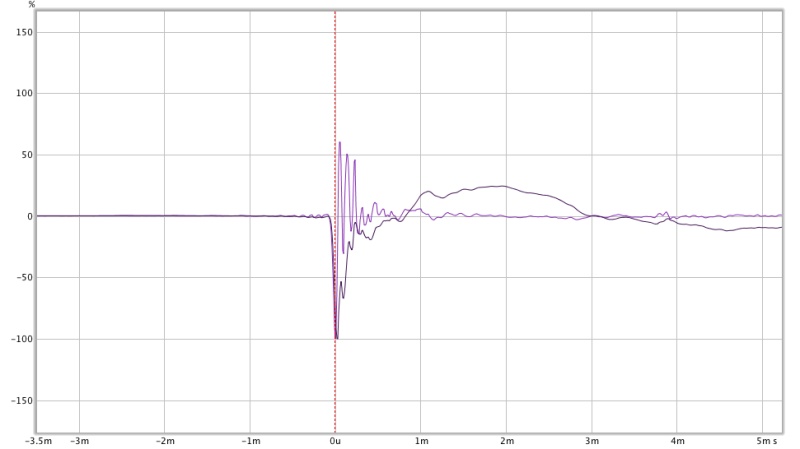
TC9:
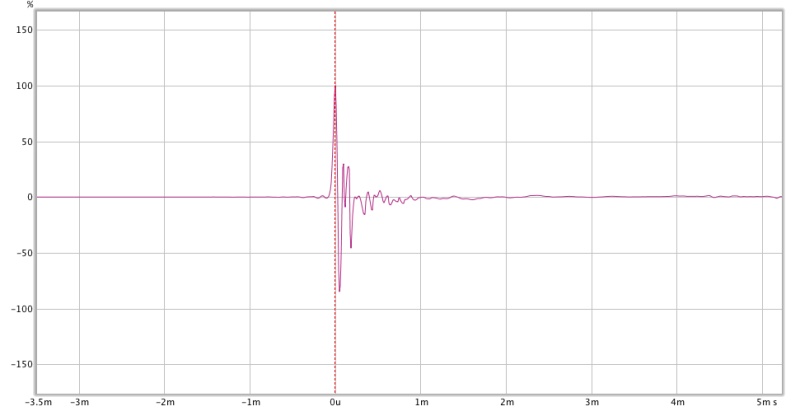
TC9 is cleaner, but not as clean as other measurements I've seen of it.
It might be worthwhile to check your electrical path, including the DAC in a loopback measurement.
While this won't sound bad, it's not what you want when thinking about an array of either of these. How do they compare to you?
Also consider the box, is there damping inside?
One of the advantages than you now have a reference.

TC9:

TC9 is cleaner, but not as clean as other measurements I've seen of it.
It might be worthwhile to check your electrical path, including the DAC in a loopback measurement.
While this won't sound bad, it's not what you want when thinking about an array of either of these. How do they compare to you?
Also consider the box, is there damping inside?
One of the advantages than you now have a reference.
Last edited:
perceval,
FR looks good enough because enclosure and room dependant but little shure HF part will change when investigated what cause the excess HF ringing which start at overmuch 80+90% negative impulse out to 200-400uS area.
Sorry message got long, hope some of below is helpful info.
If the hardware device or cascade of devices that is responsible that ringing scheme sits in your audio chain system when enjoying music playing tracks, then there should be audio able improvement and precision in the horizon when eliminated. But it could also just be a device or route you only use under measurements causing the problem such as microphone lack of bandwidth and/or abrupt HF slope cutoff, or lack of active calibration for system and michrophone inside REW settings. If REW haven't a calibration file for active sound card sample rate profile and also calibration file for microphone it expects unlimited bandwith and the devices real HF cutoff filters ringing wont be extracted in the sweep.
Suggest over time bench al devices in audio system, its is good to have confirmed if devices have good audio band specs as written in manual or perform bad in some area. Boxes with line level is easy to test in loop at sound card I/O but be care full with power amps having a resistor network at output and start at very low volume level and then up it until REW spl meter show expected dynamic. Also regarding power amps watch out for the ones that is bridged use only their cold and hot speaker connectors wired to resistor network and chassis on power amp even it has ground symbol somewhere must never get in touch with soundcard ground in this temporary test setup. REW is best test suite to look at flaws in IR/SR but when at it one can make a Rightmark Audio Analyzer sweep which can output a nice html report including dynamic range and others, but it won't see the IR flaws even it report a nice FR.
There's a chance culprit is just soundcard related as a example have a XONAR U7 and a UMC204HD they both Rings and Bings as crazy and distort wave shape at all sample rates except 176,4/192kHz where they go HQ. Problem is probably manufacture at this product price point only optimized their combined digital and analog output filters to be textbook at highest sample rate and for rest of sample rates choose cheap way setting digital filters to be steep which gives little less bandwidth plus ringing and distorted waveform output. Have a cheap UCA222 and old AP192 they both perform textbook output filter at al supported sample rates.
Checking soundcard in a loop suggest use ASIO under REW if possible and look just at IR/SR plus HD plots if there is any un-linear flaws under repeated sweeps, if this is case then tweak buffer settings in sound card device ASIO control panel until perfect plots under repeated sweeps. If ASIO then end works good suggest use always those buffer settings for that particular computer and then shift to ASIO too inside JRiver.
FR looks good enough because enclosure and room dependant but little shure HF part will change when investigated what cause the excess HF ringing which start at overmuch 80+90% negative impulse out to 200-400uS area.
Sorry message got long, hope some of below is helpful info.
If the hardware device or cascade of devices that is responsible that ringing scheme sits in your audio chain system when enjoying music playing tracks, then there should be audio able improvement and precision in the horizon when eliminated. But it could also just be a device or route you only use under measurements causing the problem such as microphone lack of bandwidth and/or abrupt HF slope cutoff, or lack of active calibration for system and michrophone inside REW settings. If REW haven't a calibration file for active sound card sample rate profile and also calibration file for microphone it expects unlimited bandwith and the devices real HF cutoff filters ringing wont be extracted in the sweep.
Suggest over time bench al devices in audio system, its is good to have confirmed if devices have good audio band specs as written in manual or perform bad in some area. Boxes with line level is easy to test in loop at sound card I/O but be care full with power amps having a resistor network at output and start at very low volume level and then up it until REW spl meter show expected dynamic. Also regarding power amps watch out for the ones that is bridged use only their cold and hot speaker connectors wired to resistor network and chassis on power amp even it has ground symbol somewhere must never get in touch with soundcard ground in this temporary test setup. REW is best test suite to look at flaws in IR/SR but when at it one can make a Rightmark Audio Analyzer sweep which can output a nice html report including dynamic range and others, but it won't see the IR flaws even it report a nice FR.
There's a chance culprit is just soundcard related as a example have a XONAR U7 and a UMC204HD they both Rings and Bings as crazy and distort wave shape at all sample rates except 176,4/192kHz where they go HQ. Problem is probably manufacture at this product price point only optimized their combined digital and analog output filters to be textbook at highest sample rate and for rest of sample rates choose cheap way setting digital filters to be steep which gives little less bandwidth plus ringing and distorted waveform output. Have a cheap UCA222 and old AP192 they both perform textbook output filter at al supported sample rates.
Checking soundcard in a loop suggest use ASIO under REW if possible and look just at IR/SR plus HD plots if there is any un-linear flaws under repeated sweeps, if this is case then tweak buffer settings in sound card device ASIO control panel until perfect plots under repeated sweeps. If ASIO then end works good suggest use always those buffer settings for that particular computer and then shift to ASIO too inside JRiver.
Hi guys!
For the measurements above, I used my old MacBookPro. Used audio out from the Mac, no other soundcard. The measurements in the living room are usually done with a PC, connected to a Presonus Audiobox 1818vsl, it is USB and has 8 outputs.
The box used for the TC9 test , I made from EVA foam, like user Jeshi made. I only had very little damping left, so I will go out and purchase some more to add to the box.
For amp, I used a small TPA3116D2 amp. Only connected the right channel.
The mic is a USB Yeti. I've read somewhere that it was ok for using with REW, but I couldn't find a calibration file.
I'll read how to do a loopback measurement.
For the measurements above, I used my old MacBookPro. Used audio out from the Mac, no other soundcard. The measurements in the living room are usually done with a PC, connected to a Presonus Audiobox 1818vsl, it is USB and has 8 outputs.
The box used for the TC9 test , I made from EVA foam, like user Jeshi made. I only had very little damping left, so I will go out and purchase some more to add to the box.
For amp, I used a small TPA3116D2 amp. Only connected the right channel.
The mic is a USB Yeti. I've read somewhere that it was ok for using with REW, but I couldn't find a calibration file.
I'll read how to do a loopback measurement.
Last edited:
TC9 in EVA foam enclosure 🙂
Goggled mic and it seems a 16bit/48kHz USB interface that's fine and same as Daytons UMM-6 where miniDSP UMIK is 24bit/48kHz.
Personally have no clue how sound system operate a MacBookPro but gold is to have as much bandwidth as possible and lets say previous measurements were at 44,1kHz there's a chance if upped to 48kHz gives less ringing.
Had it been Windows then lets say Windows sound system for mic is set at 44,1kHz and inside REW one run 48kHz then Windows sound system will do SRC to 44,1kHz so we won't get the last 48kHz bandwidth and chance SRC add a little bit distortion. So if one first set Windows sounds system control panel at 48kHz for mic USB device and also 48kHz for soundcards DAC analog out before running REW which also is set 48kHz ensure highest bandwidth and no SRC distortion in chain. This is a point where programs that support ASIO and WASAPI is much easier navigate in their exclusive direct route to control hardware wordlenght and samplerate programming.
Goggled mic and it seems a 16bit/48kHz USB interface that's fine and same as Daytons UMM-6 where miniDSP UMIK is 24bit/48kHz.
Personally have no clue how sound system operate a MacBookPro but gold is to have as much bandwidth as possible and lets say previous measurements were at 44,1kHz there's a chance if upped to 48kHz gives less ringing.
Had it been Windows then lets say Windows sound system for mic is set at 44,1kHz and inside REW one run 48kHz then Windows sound system will do SRC to 44,1kHz so we won't get the last 48kHz bandwidth and chance SRC add a little bit distortion. So if one first set Windows sounds system control panel at 48kHz for mic USB device and also 48kHz for soundcards DAC analog out before running REW which also is set 48kHz ensure highest bandwidth and no SRC distortion in chain. This is a point where programs that support ASIO and WASAPI is much easier navigate in their exclusive direct route to control hardware wordlenght and samplerate programming.
It is my understanding that Windows Direct Sound outputs 16/48 by default. Using a UMM-6 and REW on my laptop running W10 indicates this is true. If you can use WASAPI or ASIO, then you bypass Direct Sound and the internal sound card. Output sample rate is them whatever you want it to be.
Bob
Bob
Yep, but I am not using Direct Sound, I have this USB audio interface that does the DAC and gives me 8 outputs (I'm using 6 in my 5.1 setup, 3 when doing stereo plus sub in a 2.1).
The UCA222 mentioned by Byrtt only has 2 outputs, so I can't use that with Jriver and its own crossovers.
An externally hosted image should be here but it was not working when we last tested it.
The UCA222 mentioned by Byrtt only has 2 outputs, so I can't use that with Jriver and its own crossovers.
- Status
- Not open for further replies.
- Home
- Loudspeakers
- Full Range
- Aura wannabe... maybe
